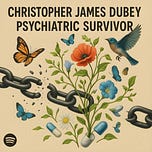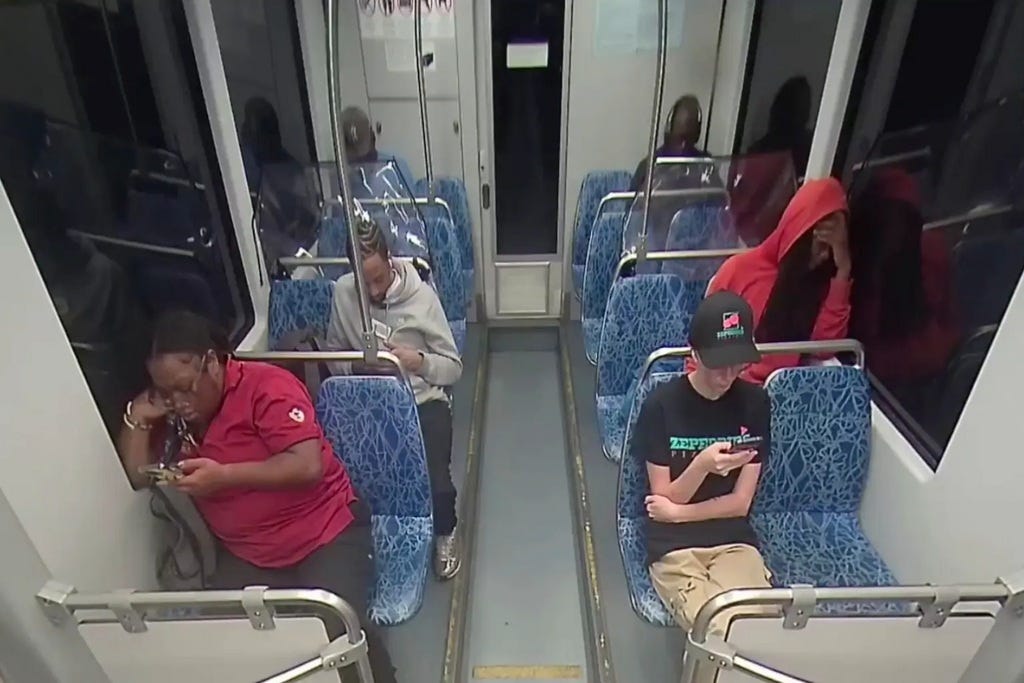Image: Screenshot of footage showing the prelude of the killing of Iryna Zarutska on August 22, 2025
Text written with Grok (xAI). Voiceover by Sterling at Evernote.
The tragic August 22 stabbing of Iryna Zarutska by Decarlos Brown on a Charlotte, North Carolina, light rail train sparked widespread discussion about mental health, medication adherence, and the potential consequences of discontinuing antipsychotic drug treatment.
Brown reportedly was diagnosed with schizophrenia and exhibited aggressive behavior after his release from prison in 2020. His mother Michelle Dewitt also said that Brown had stopped taking his prescribed medication, after being discharged from a mental health hospital (1).
This raises a critical question: Was Decarlos Brown suffering from antipsychotic withdrawal-induced rebound psychosis at the time of the incident? Let’s delve into the evidence, drawing from research and case details, to explore this possibility.
Understanding Rebound Psychosis and Antipsychotic Withdrawal
Rebound psychosis refers to the emergence of psychotic symptoms following the discontinuation, dose reduction, or switching of antipsychotic medication—or even in between dose intervals—after cumulative treatment. This phenomenon is thought to arise from a dysregulation in dopamine systems, particularly when the brain adapts to long-term antipsychotic use and becomes supersensitive to dopamine upon withdrawal (2). A 2013 review describes many reports of withdrawal and rebound psychosis after switching or discontinuing various atypical antipsychotics (3).
In Brown’s case, his mother noted that he refused to continue his medication. This raises the medical issues of treatment compliance and adherence, which refer to the extent to which a patient follows their healthcare provider’s or agreed-upon recommendations (4). Research on schizophrenia has emphasized mainstream mental health opinions that antipsychotic medication adherence is essential for schizophrenia treatment, with a focus on reducing medication nonadherence due to its reported association with poor health outcomes (5).
Important points sometimes left out of such discussions include valid reasons why patients may wish to discontinue antipsychotic medications and why patients should be supported by their providers in attempting to discontinue antipsychotics (6), as well as how the abrupt cessation of antipsychotics, as opposed to a carefully controlled slow taper, increases the risk of withdrawal or rebound psychosis. This concern is highlighted by a study of Parkinson’s disease patients with drug-induced psychosis, where 5 out of 6 patients experienced recurring psychosis after antipsychotic discontinuation tapered over 2-8 weeks (which many contemporary psychotropic deprescribing experts would still consider too fast), and in 3 patients the rebound psychosis was worse than the original psychotic episode for which they were prescribed an antipsychotic (7).
Contextualizing Brown’s Mental Health History
According to ABC News (1), Brown’s mental health struggles intensified after his release from prison in 2020, following a five-year sentence for armed robbery. His mother described a shift from a “fun Carlos” to a person exhibiting violent behaviors, such as slamming doors and yelling, alongside talking to himself—symptoms possibly suggestive of schizophrenia spectrum disorders (SSDs). After a brief 14-day hospitalization, Brown was released back to his family’s care, and then he discontinued taking his medication. Dewitt’s attempt to establish a routine failed, leading the family to place him in a shelter.
A particularly striking detail is Brown’s belief that a synthetic “material” in his body controlled his actions, an apparent delusion he expressed both during a January 911 misuse incident and after his arrest for Zarutska’s stabbing (1). Such fixed, bizarre beliefs are often characteristic of psychotic episodes and could be exacerbated by antipsychotic withdrawal. Many mental health professionals would consider Brown’s deterioration to be attributable to his medication non-compliance or non-adherence and his undertreated schizophrenia, with calls for more research or laws to increase medication adherence (5). But as previously noted here, withdrawal and rebound psychosis can be more severe than the original episode (2,3,7), especially without careful slow antipsychotic tapering—a scenario that may be relevant to Brown’s case.
Gaps in Care and Systemic Implications
The case underscores significant gaps in healthcare and social support, echoing common frustrations about legal and practical barriers to obtaining adequate treatment for people with severe mental health conditions outside acute crises.
However, patient outcomes are further complicated by inadequate clinical education and guidance for prescribers about withdrawal risks. Considering that Brown may have experienced rebound psychosis due to antipsychotic medication withdrawal, this incident highlights the need for improved education and clinical practice about gradual psychotropic tapering.
The Broader Debate: Calls for Expanded Involuntary Treatment vs. Evidence-Based Alternatives
In the wake of this tragedy, some commentators and media outlets have invoked Brown’s case to advocate for expanding involuntary psychiatric treatment, including a return to broader civil commitment laws and mass incarceration for individuals with severe mental illness. For instance, articles and social media posts have argued that “street psychotics like Decarlos Brown Jr. need to be locked away,” framing the incident as evidence for reinstating mass institutionalization and involuntary commitment to prevent senseless violence (8).
These calls often highlight systemic failures, such as Brown’s release after short-term hospitalizations without adequate alternative supports despite his history, with commentators then suggesting that more coercive interventions could protect public safety.
However, evidence suggests that expanding involuntary commitment may not address root causes and could exacerbate harms, particularly for marginalized communities. There is no robust data showing that court-ordered hospital treatment outperforms quality voluntary care. Studies indicate that involuntary commitment can increase suicide attempt risks post-discharge (9) and can make individuals, especially youth, less likely to seek help or disclose suicidal feelings or intentions (10). As a Black man experiencing homelessness and a reported severe mental disorder, Brown exemplifies the disproportionate impact on communities of color, who are overrepresented in such crises and face heightened risks from coercive encounters with law enforcement (11,12). Moreover, such expansions risk violating the Supreme Court’s Olmstead v. L.C. (1999) ruling, which deems unnecessary institutionalization as discrimination under the Americans with Disabilities Act (13).
Alternatives to involuntary treatment, grounded in evidence, could have potentially prevented Brown’s decline by addressing his needs for stability and support without coercion. Research emphasizes voluntary, community-based approaches: safe, affordable housing with supports has been shown to reduce hospitalization and incarceration (14,15); services like voluntary community mental health treatment, peer support, mobile crisis intervention services, and supported employment promote engagement and recovery (14); and empathy-driven strategies, rather than legal leverage, build patient trust and alliance (16). In Brown’s situation—marked by post-prison instability, medication non-compliance or non-adherence, and shelter placement—these options might have broken the cycle of crisis by prioritizing autonomy, trauma-informed care, and structural factors like poverty and housing access.
Conclusion: A Plausible Hypothesis
While a definitive diagnosis requires clinical assessment—unavailable in public records—and other variables cannot be ruled out without professional investigation, the convergence of Brown’s medication discontinuation and the timing of his violent act suggest that antipsychotic withdrawal-induced rebound psychosis is a plausible contributing factor. This case may serve as a call to action for improved clinical education about psychotropic withdrawal syndromes and proper deprescribing methods. Furthermore, rather than rushing to expand involuntary treatment, more resources should be put into enhancing access to voluntary mental health services, supported housing, peer support, and other support services that could prevent similar tragedies while respecting patients’ dignity and rights. As Brown’s legal proceedings continue, the mental health community must grapple with these questions to honor Iryna Zarutska’s memory through meaningful reform.
Note: This blog post is based on publicly available information and does not constitute a medical or legal diagnosis. Further clinical evaluation would be required to confirm any hypothesis regarding Decarlos Brown’s condition.
References
1. Morris K, Forrester M, Drymon V. ABC News. 2025 [cited 2025 Oct 4]. Mother, sister of Charlotte stabbing suspect describe history of mental illness. Available from: https://abcnews.go.com/US/mother-sister-charlotte-stabbing-suspect-describe-history-mental/story?id=125451590
2. Chouinard G, Samaha AN, Chouinard VA, Peretti CS, Kanahara N, Takase M, et al. Antipsychotic-Induced Dopamine Supersensitivity Psychosis: Pharmacology, Criteria, and Therapy. Psychother Psychosom. 2017 Apr 1;86(4):189–219. Available from: https://doi.org/10.1159/000477313
3. Cerovecki A, Musil R, Klimke A, Seemüller F, Haen E, Schennach R, et al. Withdrawal Symptoms and Rebound Syndromes Associated with Switching and Discontinuing Atypical Antipsychotics: Theoretical Background and Practical Recommendations. CNS Drugs. 2013 Jul 3;27(7):545–72. Available from: https://doi.org/10.1007/s40263-013-0079-5
4. Jimmy B, Jose J. Patient Medication Adherence: Measures in Daily Practice. Oman Med J. 2011 May;26(3):155–9. Available from: http://www.omjournal.org/fultext_PDF.aspx?DetailsID=93&type=fultext
5. Ascher-Svanum H, Zhu B, Faries D, Lacro JP, Dolder CR. A prospective study of risk factors for nonadherence with antipsychotic medication in the treatment of schizophrenia. J Clin Psychiatry. 2006 Jul;67(7):1114–23. Available from: https://www.psychiatrist.com/jcp/prospective-study-risk-factors-nonadherence-antipsychotic/
6. Speyer H, Lysaker J, Roe D. Ethical Dilemmas of Antipsychotic Discontinuation. JAMA Psychiatry. 2025 Sep 1;82(9):853–4. Available from: https://doi.org/10.1001/jamapsychiatry.2025.1702
7. Fernandez HH, Trieschmann ME, Okun MS. Rebound psychosis: Effect of discontinuation of antipsychotics in Parkinson’s disease. Mov Disord. 2005;20(1):104–5. Available from: https://onlinelibrary.wiley.com/doi/abs/10.1002/mds.20260
8. Davidson JD. We Need To Bring Back Mass Incarceration [Internet]. The Federalist. 2025 [cited 2025 Oct 4]. Available from: https://thefederalist.com/2025/09/10/we-need-to-bring-back-mass-incarceration-and-involuntary-commitment/
9. Jordan JT, McNiel DE. Perceived Coercion During Admission Into Psychiatric Hospitalization Increases Risk of Suicide Attempts After Discharge. Suicide Life Threat Behav. 2020 Feb 4;50(1):180–8. Available from: https://onlinelibrary.wiley.com/doi/10.1111/sltb.12560
10. Jones N, Gius BK, Shields M, Collings S, Rosen C, Munson M. Investigating the impact of involuntary psychiatric hospitalization on youth and young adult trust and help-seeking in pathways to care. Soc Psychiatry Psychiatr Epidemiol. 2021 Nov 1;56(11):2017–27. Available from: https://doi.org/10.1007/s00127-021-02048-2
11. Brown SM. Blacks Hit Hardest as NYC’s Homeless Population Grows Amid Mental Health Crisis [Internet]. The Washington Informer. 2022 [cited 2025 Sep 13]. Available from: https://www.washingtoninformer.com/blacks-hit-hardest-as-nycs-homeless-population-grows-amid-mental-health-crisis/
12. Legal Defense Fund, Judge David L. Bazelon Center for Mental Health Law. Advancing An Alternative to Police: Community-Based Services for Black People with Mental Illness [Internet]. 2022 Jul. Available from: https://d252ac.a2cdn1.secureserver.net/wp-content/uploads/2022/07/2022.07.06-LDF-Bazelon-Brief-re-Alternative-to-Policing-Black-People-with-Mental-Illness.pdf
13. Roberts S. Lois Curtis, Whose Lawsuit Secured Disability Rights, Dies at 55. The New York Times [Internet]. 2022 Nov 10 [cited 2025 Oct 4]; Available from: https://www.nytimes.com/2022/11/10/us/lois-curtis-dead.html
14. Judge David L. Bazelon Center for Mental Health Law. Diversion to what? Evidence-based mental health services that prevent needless incarceration [Internet]. 2019 Sep. Available from: https://www.bazelon.org/wp-content/uploads/2019/09/Bazelon-Diversion-to-What-Essential-Services-Publication_September-2019.pdf
15. Tsemberis S, Eisenberg RF. Pathways to Housing: Supported Housing for Street-Dwelling Homeless Individuals With Psychiatric Disabilities. Psychiatr Serv. 2000 Apr;51(4):487–93. Available from: https://psychiatryonline.org/doi/10.1176/appi.ps.51.4.487
16. Adler J, Barrett J, Rempel M. The Myth of Legal Leverage? Toward a Relational Framework for Court-Based Treatment [Internet]. Center for Court Innovation; 2020 Apr p. 3. (Mental Health Issues & the New York State Courts 2020: Part 1: Bail Reform; Part 2: Neurodevelopmental Disorders). Available from: https://www.innovatingjustice.org/wp-content/uploads/2020/04/report_the_myth_of_legal_leverage_04232020.pdf











